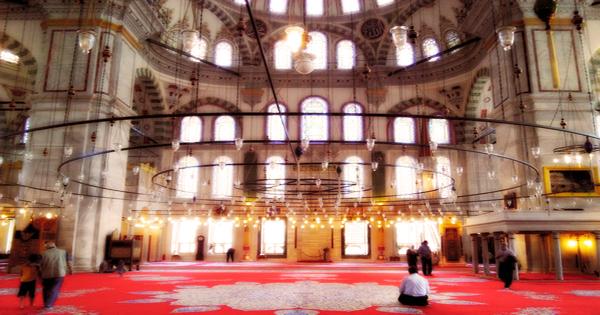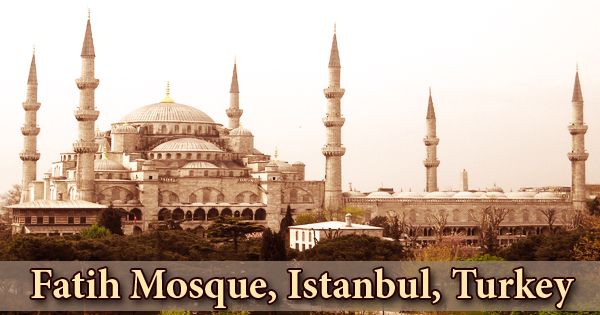The Fatih Mosque (Turkish: Fatih Camii, “Conqueror’s Mosque” in English) designed by Ottoman Sultan Mehmed II to commemorate his conquest of Constantinople, is the sanctuary and central building of the imperial complex. It is an Ottoman mosque in Istanbul’s Fatih district, Turkey. The original mosque on the site was built on the site of the Holy Apostles’ Church between 1463 and 1470. His tomb is behind the mosque and is invariably packed with worshipers; Mehmed wanted to be buried here as well. The mosque was badly damaged in the earthquake of 1766 and was reconstructed to a new style in 1771. It is one of Istanbul’s greatest examples of Ottoman-Islamic architecture and represents a significant stage in the growth of Ottoman classical architecture.

Aerial view of the Fatih Mosque and the surrounding Külliye.
The architect of the mosque, as of the complex, was a man by the name of the Greek architect Atik Sinan (Sinan the Elder). Between 1463/867 AH and 1470/875 AH, primary sources say that he founded the mosque. The mosque is named after the Ottoman Sultan Mehmed the Conqueror, the Ottoman sultan who conquered Constantinople in 1453, known in Turkish as Fatih Sultan Mehmed. The mosque has suffered a lot of damage since its completion and has been restored. Fatih Mosque Complex used to include many other buildings, including madrasas (religious high schools), student dormitories, hospice, library, hospital, market, hammam, and tombs; only madrasas, library, hospice, and tombs survive today, sadly. As a result of the fires, earthquakes, and road development in the 1950s, other buildings were demolished.
First, after some damage caused by the 1509/915 AH earthquake, the mosque was rebuilt. The mosque dome then collapsed in the 1766/1179 AH earthquake and was completely rebuilt in 1771/1185 AH by the order of Mustafa III. As part of the Fatih Mosque, Sahn-i Seman Medrese, a major center for the study of various traditional Islamic sciences, such as theology, law, medicine, astronomy, physics, and mathematics, was founded by the Turkish astronomer Ali Qushji, invited to his court in Istanbul by Mehmed. Also, there is a wide courtyard in the hospice on the southeast of the Fatih Mosque and it is adorned with sixteen beautiful columns made of antico verdo, granite, and marble. These columns are thought to have been saved from the Holy Apostles’ Church. After Hagia Sophia, the Church of the Holy Apostles was the most powerful church during the Byzantine era and a number of Byzantine emperors were buried there, including Constantine I.

Fatih Mosque, Istanbul
The original complex, running along the Golden Horn side of Fevzipasa Lane, covered almost a square area of 325 meters (1,066 feet) on one side. In the center of the symmetrically organized complex, the mosque stands at the center of an expansive, open precinct, all aligned 32 degrees east of the south in accordance with the qibla. The complex is located at the top of one of the seven hills in Istanbul and on the former site of the Church of the Byzantine Holy Apostles. However, during the earthquakes of 1509, 1557, and 1754, the original mosque, built-in 1470, was severely damaged. Finally, after the main dome collapsed and the walls were irreparably damaged, an earthquake on 22nd May 1766 completely destroyed it. In 1771, during the reign of Mustafa III, the architect Mehmet Tahir completed the present mosque, constructed on a radically different plan from the mosque of the fifteenth century.
The first Fatih Mosque had a single central dome supported on the side of the qibla by a single semi-dome of the same diameter and suspended on four arches, the dome having a diameter of 26 meters. The Fatih Mosque Complex Courtyard is one of the main mosque patios, so the funeral ceremonies of important people take place in the Fatih Mosque. The second mosque, founded by Sultan Mustafa III (1771) after the earthquake of 1766, was built on a square plan. It has one central dome with four semi-domes supporting it. The biggest street market in Istanbul (Fatih Pazarı) takes place around Fatih Mosque every Wednesday.
Walls on the northwestern and southeastern sides and a line of madrasas on its lateral (northeastern and southwestern) sides enclosed the precinct around the mosque. Two gates provided entry to the precinct on the northwestern and southeastern walls, as did a number of gates between the madrasas. From the original construction, the courtyard, main entrance portal, and lower portions of the minarets remain, with the remainder consisting of the Baroque restoration of 1771. A wide prayer hall followed by a courtyard formed part of the mosque. The courtyard was rectangular with an arcade surrounding it, three of which remain to this day.

Interior view of Fatih Mosque
A prayer hall with a tall dome supported on the side of the qibla by a semi-dome of equal radius and three monumental arches on the three remaining sides. Three domed bays to the east and west were flanked by this ensemble. The Fatih Mosque’s present interior is basically a replica of earlier designs invented by Sinan, frequently replicated in Istanbul by himself and his successors (this technique is emulative of the Hagia Sophia). The portal, the mihrab, and the lower shafts of the minarets belonging to the original building have also been integrated into Mustafa III’s new mosque. The central dome with a diameter of 26 meters is surrounded by four semi-domes on each axis supported by four wide columns of marble. Each one of them has two minarets with twin galleries.
The calligraphy inside the mosque and the mimbar exhibits a Baroque influence, but the inferior quality white tiles are a weak contrast with mosques such as the Rüstem Pasha Mosque’s İznik tiled splendor. Mihrab dates from the original building. Granite, white marble, and greenstone are carved into the columns of the gallery. Every window’s tympanum is decorated with Qur’anic inscriptions in white and green marble on the side of the precinct. Ceramic tiles decorate the tympanum of two windows inside the portico of the mosque with other inscriptions. As with other imperial mosques in Istanbul, the Fatih Mosque was built to serve both religious and cultural needs as a kulliye, or complex with adjacent structures.

Fatih Mosque courtyard
The entrance to the prayer hall is marked by the raised dome and the green and white voussoir of the portico’s central bay. With the addition of a balcony above its ribbed semi-vault and a raised terrace (mahfil) with side bays at its front, the muqarnas portal, retained from the original construction, has been transformed on the inside. The Sahn-ı Seman, eight great medreses, four on each side, are to the north and south of the mosque. The Türbe of Sultan Mehmet II and his wife Gulbahar Hatun are in the cemetery on the Kiblah side behind the mosque. Following the earthquake, both were rebuilt. The interior’s decorative painting reflects the baroque influence on Ottoman architecture of the 18th century.
There is a domed library on the Kiblah side of the mosque, linked to it, which was built in 1724. One of its doors opens into the street, while the other two doors open into the mosque’s inner courtyard. The library is undergoing repairs, and the books at the Suleymaniye Library are being secured. The Fatih Mosque is open every day from 9am-6pm but closed at prayer times; during Friday noon prayers, the mosque is very busy. The side walls were taken in to accommodate sheltered terraces on either side that have rows of faucets for ablution when restoring the mosque. On the eastern corner adjoining the marble royal lodge (hünkar mahfili), a ramp was designed to allow the sultan on his horse to enter.
Two minarets with single balconies were in the original Fatih Mosque. They were reconstructed after the earthquake with two minarets, combining the old foundations and the lower shafts. During the 19th century, the minarets were rebuilt in empire style; in 1965, their stone spires were replaced by lead spires, with no modification to the balconies. Like other public mosques in Istanbul, Fatih Mosque does not have an entrance fee or a ticket price, so donations are welcome. There is no longer a hospital, a market, kitchens, and a hammam belonging to the original complex. In order to repair damage caused by the earthquake on August 18, 1999, the mosque is currently under reconstruction.
Information Sources:





